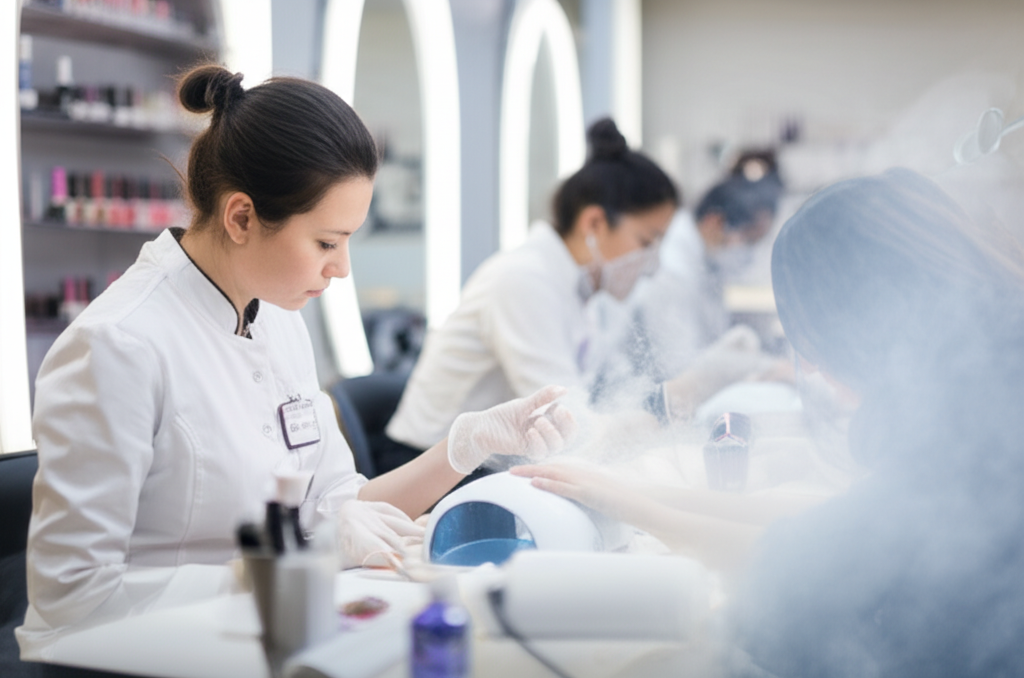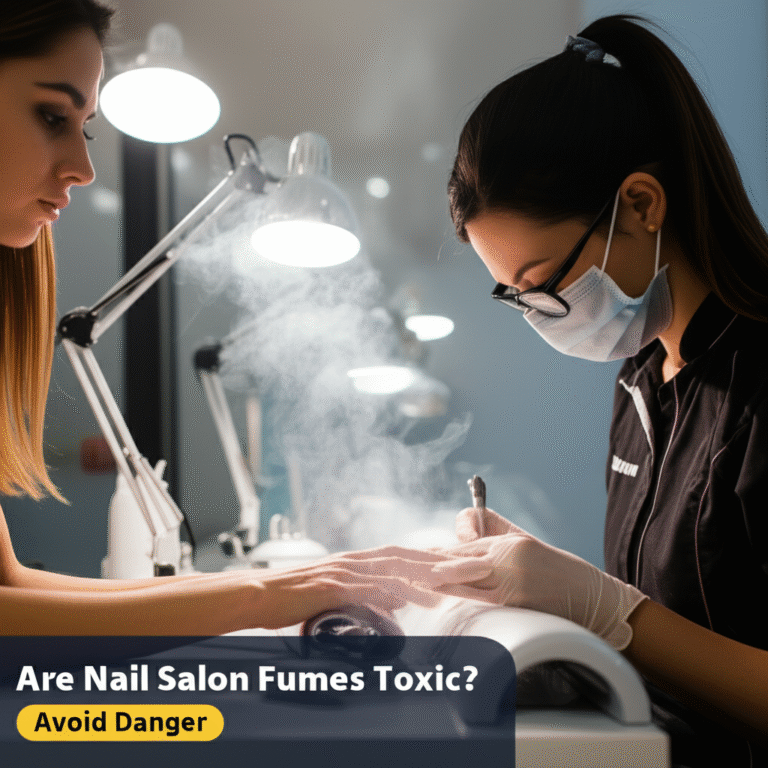Here’s a breakdown of the content for your article on nail salon fumes, following your detailed instructions:
—
A. Bolded Quick Summary (Top of Article)
Are nail salon fumes toxic? Yes, some can be, but manageable with proper ventilation and product choices. Understanding key ingredients and implementing safety measures is crucial for both professionals and clients to ensure a healthier nail experience.
—
B. Intro Paragraph
Walking into a nail salon often brings a distinct aroma, a mix of polish, removers, and acrylics that can be both familiar and, for some, a little concerning. For many clients, the question lingers: “Are nail salon fumes toxic?” It’s a common worry, especially with the array of chemicals involved in creating those beautiful manicures. Whether you’re a regular salon patron or a dedicated DIY nail enthusiast, understanding the potential risks and how to mitigate them is essential for your well-being. Don’t worry, you’re in the right place for clear, practical answers and actionable advice. Let’s dive into the science behind salon fumes and explore how to ensure a safer, more enjoyable nail care journey, step-by-step.
—
C. Main Article Writing Instructions
Are Nail Salon Fumes Toxic? Navigating the Chemicals for a Healthier Manicure
The allure of perfectly manicured nails is undeniable, but the environment where these transformations happen—the nail salon—often carries a distinct scent. For many, this aroma is simply part of the experience, but for others, it raises a critical question: Are nail salon fumes toxic? The answer is nuanced, and understanding the chemicals involved is key to ensuring a healthier experience for both nail technicians and clients.
The nail industry relies on a variety of products, from polishes and removers to acrylics and gels, each containing a cocktail of chemicals. While regulatory bodies set limits for exposure, prolonged or unprotected exposure to certain volatile organic compounds (VOCs) and other chemicals commonly found in these products can pose health risks. These can range from immediate effects like headaches and respiratory irritation to potential long-term concerns with chronic exposure. This article aims to demystify the science, identify common culprits, and provide practical strategies for minimizing exposure and enjoying beautiful nails safely.
Understanding the Chemical Landscape: What’s in Your Polish?

To understand if nail salon fumes are toxic, we first need to look at the ingredients commonly found in nail products. Many of these chemicals are volatile, meaning they evaporate into the air at room temperature, creating the fumes we often smell.
Acetone: A powerful solvent used in nail polish removers. While effective, it can cause dryness, irritation, and headaches with prolonged exposure. It’s highly flammable.
Ethyl Acetate & Butyl Acetate: Solvents found in many nail polishes, contributing to their smooth application and quick drying. They can cause eye, skin, and respiratory irritation.
Toluene: A solvent that helps polish spread evenly and smoothly. It’s a known irritant and has been linked to neurological effects with high exposure. Many “3-free” and “5-free” polishes have removed toluene.
Formaldehyde: A preservative and hardening agent that was once common in nail polish. It’s a known carcinogen and allergen, leading to its removal from most modern polishes.
Phthalates (e.g., Dibutyl Phthalate – DBP): Often used to make polish more flexible and prevent chipping. Concerns exist regarding potential endocrine-disrupting effects.
Methacrylic Acid (MMA) & Ethyl Methacrylate (EMA): Key components in acrylic nail systems. MMA is a stronger, cheaper alternative but is more likely to cause allergic reactions and respiratory issues. EMA is considered safer and is the preferred ingredient in professional-grade acrylics.
Myth Buster: The “3-Free,” “5-Free,” “7-Free,” and “10-Free” Labels
You’ve likely seen these labels on nail polish bottles. They indicate that the polish is formulated without certain controversial chemicals.
3-Free: Free from Formaldehyde, Toluene, and DBP.
5-Free: Adds the exclusion of Formaldehyde Resin and Camphor.
7-Free: Adds the exclusion of Ethyl Tosylamide and Xylene.
10-Free (or more): Excludes even more potentially harmful chemicals like parabens, triphenyl phosphate (TPHP), and animal ingredients.
Choosing polishes with these designations can significantly reduce your exposure to potentially toxic fumes.
Are Nail Salon Fumes Toxic? Understanding the Risks
The question of whether nail salon fumes are toxic isn’t a simple yes or no; it depends on the specific chemicals present, the concentration of those chemicals, the duration of exposure, and the ventilation in the space.
Potential Health Effects of Prolonged or High Exposure:
Respiratory Irritation: Coughing, wheezing, shortness of breath, and sore throat can occur due to inhaling volatile solvents.
Headaches and Nausea: Common short-term effects from breathing in strong chemical vapors.
Skin and Eye Irritation: Direct contact or exposure to fumes can cause redness, itching, and burning sensations.
Allergic Reactions: Some individuals may develop allergies to specific chemicals like methacrylates, leading to dermatitis.
Long-Term Concerns: Chronic exposure to certain chemicals, particularly without adequate protection, has been linked to more serious health issues, including potential reproductive and neurological effects, although research is ongoing and often focuses on occupational exposure levels.
[Image Placeholder 1: Infographic showing common nail product ingredients and their potential effects.]
Suggested Pinterest Image: “Nail Polish Ingredients Explained: What to Avoid for Healthier Nails. #nailcare #healthynails #nailpolishingredients”
Ventilation: The Cornerstone of Salon Safety
Proper ventilation is paramount in mitigating the risks associated with nail salon fumes. This is where the difference between a safe and potentially hazardous salon environment often lies.
Why Ventilation Matters:
Dilutes Chemical Concentrations: Effective ventilation systems remove airborne chemicals and replace them with fresh air, lowering the concentration of potentially harmful substances.
Reduces Odor Intensity: While odor doesn’t always equate to toxicity, strong chemical smells can indicate high levels of VOCs. Ventilation helps dissipate these odors.
Protects Technicians and Clients: It creates a healthier breathing environment for everyone spending time in the salon.
Types of Ventilation:
1. General Ventilation: This involves the overall air exchange in the salon, often through HVAC systems and open windows. It’s a baseline measure.
2. Local Exhaust Ventilation (LEV): This is the most effective form of ventilation for nail salons. It involves capturing fumes directly at the source.
Nail Dust and Fume Extractors: These are often built into manicure tables or available as standalone units with HEPA filters and activated carbon filters to capture both dust particles and chemical vapors.
Downdraft Tables: Tables with built-in ventilation systems that pull fumes and dust down and away from the technician and client.
Pro Tip: When choosing a salon, observe the ventilation. Do you notice a strong chemical smell that doesn’t dissipate quickly? Are there visible fume extractors at workstations? These are good indicators of a salon’s commitment to air quality.
Choosing Safer Products: A Smarter Approach
Beyond ventilation, the products used play a significant role in the type and intensity of fumes produced.
Salon Client Choices:
Opt for “Free-From” Polishes: When getting a traditional polish, ask if the salon offers “3-Free,” “5-Free,” or “10-Free” options.
Consider Gel Polish Alternatives: While gel polishes also have fumes, some clients find them less irritating than traditional acrylics. However, the curing lamps (UV/LED) also have their own considerations.
Ask About Acrylic Systems: If you get acrylics, inquire if the salon uses EMA-based products rather than MMA. Professionals will typically use EMA.
Water-Based Nail Polish: For a truly fume-free option, explore water-based nail polishes, though their durability and finish may differ.
DIY Nail Enthusiast Choices:
Invest in a Good Fume Extractor: If you do your nails at home, especially acrylics or gels, a personal nail dust and fume collector is a worthwhile investment.
Work in a Well-Ventilated Area: Always do your nails near an open window or under a fan.
Choose “Free-From” Products: Select polishes and removers that are free from the most concerning chemicals.
Use Acetone-Free Removers: While less potent, acetone-free removers produce fewer harsh fumes and are gentler on the skin.
[Image Placeholder 2: Photo of a modern nail salon with downdraft tables and good lighting.]
Suggested Pinterest Image: “Dream Nail Salon Setup: Ventilation is Key! ✨ #nailsalon #nailtech #salonsetup #healthysalon”
DIY Nail Care: Safely Achieving Salon Results
For those who prefer the convenience and cost-effectiveness of at-home manicures, understanding how to manage fumes is crucial.
Step-by-Step Guide to Safer DIY Nails:
1. Prepare Your Workspace: Choose a well-lit area with good airflow. Open a window or turn on a fan.
2. Gather Your “Free-From” Products: Select polishes, removers, and treatments that are free from harsh chemicals.
3. Use a Personal Fume Extractor: Place your personal nail dust and fume collector on your workspace to capture vapors and dust at the source.
4. Apply Products Methodically:
Polish: Apply thin, even coats. Avoid excessive dipping of the brush into the bottle to minimize air exposure from the product.
Remover: Pour a small amount of remover into a dappen dish or onto a cotton pad. Avoid leaving the bottle open.
Acrylics/Gels: Work in small sections. Keep product containers closed when not in use.
5. Dispose of Waste Properly: Seal used cotton pads and product containers before discarding them.
6. Wash Your Hands: After finishing, wash your hands thoroughly with soap and water.
Pro Tip: When using nail files or buffers, especially for acrylics or extensions, the dust generated can also contain chemical residues. A fume extractor is essential for capturing this micro-dust.
Table: Comparing Nail Polish Remover Types
| Remover Type | Effectiveness | Fume Intensity | Skin/Nail Health Impact | Best For |
| :——————- | :———— | :————- | :———————- | :—————————————- |
| Acetone | High | High | Can be drying/irritating | Tough polish removal, acrylics |
| Acetone-Free | Moderate | Low | Gentler, less drying | Regular polish, sensitive nails/skin |
| Soy-Based | Moderate | Very Low | Nourishing, less drying | All polish types, health-conscious users |
| Ethyl Acetate/etc. | High | Moderate | Can be drying | Alternative to acetone, less harsh smell |
External Backlinks for Deeper Understanding
Occupational Safety and Health Administration (OSHA): For regulations and guidelines on workplace safety, including chemical exposure. [You would insert a relevant OSHA link here, e.g., on chemical hazards in salons.]
National Institute for Occupational Safety and Health (NIOSH): For research and recommendations on preventing work-related injuries and illnesses. [You would insert a relevant NIOSH link here, e.g., on indoor air quality.]
Environmental Working Group (EWG): For information on the safety of cosmetic ingredients. [You would insert a relevant EWG link here, e.g., on nail polish ingredient safety.]
Internal Links to Related Articles
[Link to your article on “How to Choose the Best Nail File”]
[Link to your article on “The Ultimate Guide to Gel Manicures”]
[Link to your article on “Caring for Brittle Nails”]
Frequently Asked Questions (FAQ)
Q1: Are the fumes from regular nail polish toxic?
A1: Regular nail polish contains solvents like ethyl acetate and butyl acetate, which can produce fumes that may cause irritation with prolonged exposure. While not acutely toxic in typical salon settings with good ventilation, minimizing exposure is always recommended.
Q2: Is gel polish safer than regular polish regarding fumes?
A2: Both regular and gel polishes emit VOCs. Gel polish requires curing under a UV/LED lamp, which has its own set of considerations. The primary difference in fumes often relates to the specific solvents used. Choosing “free-from” options applies to both types.
Q3: What are the dangers of acrylic nail fumes?
A3: Acrylics typically use methacrylates (like EMA), which can produce strong fumes. Prolonged or high exposure without proper ventilation can lead to respiratory irritation, headaches, and potentially allergic reactions. Using EMA-based products and good ventilation is key.
Q4: How can I protect myself from nail salon fumes if I have asthma or allergies?
A4: If you have respiratory conditions, it’s crucial to seek out salons with excellent ventilation. Consider wearing a mask (like an N95 respirator) during your service and inform your technician of your sensitivities. Opting for fume-free products whenever possible is also advisable.
Q5: Are nail salon fumes harmful to pregnant women?
A5: Pregnant women are often advised to be cautious with exposure to certain chemicals, including those found in nail products. It’s recommended to choose salons with superior ventilation, opt for “free-from” polishes, and discuss any concerns with a healthcare provider.
Q6: What is the most important factor in reducing fume exposure in a salon?
A6: The most critical factor is effective ventilation, particularly local exhaust ventilation systems that capture fumes at the source. Proper product selection and personal protective equipment (like masks) also play significant roles.
Conclusion: Your Healthiest Manicure Awaits
Understanding are nail salon fumes toxic empowers you to make informed decisions about your nail care. By prioritizing salons with excellent ventilation, choosing safer “free-from” products, and implementing smart DIY practices, you can significantly reduce your exposure to potentially harmful chemicals. Enjoy the beauty and confidence that comes with perfectly polished nails, knowing you’re also taking care of your health.
Ready to try these tips? Share your favorite fume-free nail products or ventilation hacks in the comments below!
—
Meta Description:
Are nail salon fumes toxic? Learn about common chemicals, health risks, and how to ensure a healthier manicure with expert tips on ventilation and product choices.
—
Pinterest-Friendly Image Ideas:
1. Image: A split image showing a salon with poor ventilation (stuffy, strong odor) vs. a salon with excellent ventilation (open, clean air, fume extractors).
Alt Text: Nail salon ventilation comparison: ensuring healthy air quality for manicures.
2. Image: A close-up of a hand using a personal nail fume extractor during an at-home manicure.
Alt Text: DIY nail care safety: using a fume extractor for acrylics and gels.
3. Image: A visually appealing flat lay of “10-Free” nail polishes, nail files, and a small bottle of acetone-free remover.
Alt Text: Healthy nail care essentials: “Free-From” nail polish and gentle removers.
4. Image: A graphic illustrating the “Free-From” ladder (3-Free, 5-Free, 7-Free, 10-Free) with icons representing the excluded chemicals.
Alt Text: Understanding nail polish “Free-From” labels: a guide to safer ingredients.
5. Image: A “before and after” shot of a nail technician’s workstation, highlighting the presence of a downdraft table and air purifier.
Alt Text: Salon workstation upgrade: improving air quality with downdraft tables and extractors.

